

InfluxDB and vRealize Network Insight compete in the data management and analytics sphere, with InfluxDB having the edge in time-series data processing due to its performance and scalability, while vRealize Network Insight excels in network infrastructure oversight with its advanced monitoring capabilities.
Features: InfluxDB offers advanced analytics and efficient time-series data handling, along with seamless integration with multiple data sources, enhancing its functionality. Meanwhile, vRealize Network Insight stands out with in-depth network traffic analysis, robust policy enforcement, and visual network maps, providing comprehensive oversight.
Room for Improvement: InfluxDB could enhance its customer service offerings and expand its integration with additional monitoring solutions. Additionally, improving user interface design would streamline user interaction. vRealize Network Insight could reduce the complexity of its setup process, offer more flexible pricing options, and further enhance its reporting capabilities for greater usability.
Ease of Deployment and Customer Service: InfluxDB is favored for its straightforward setup and open-source flexibility, though its customer service is adequate but could be improved. vRealize Network Insight requires more intricate configuration but benefits from VMware’s robust support infrastructure, providing superior service solutions despite initial complexity.
Pricing and ROI: InfluxDB represents a cost-effective option with lower setup costs and attractive long-term ROI thanks to its efficient data storage solutions. In contrast, vRealize Network Insight incurs higher initial expenses, but its extensive network management features ensure significant ROI by optimizing performance, making it a sound investment for advanced network oversight needs.
| Product | Market Share (%) |
|---|---|
| InfluxDB | 0.6% |
| vRealize Network Insight | 0.5% |
| Other | 98.9% |


| Company Size | Count |
|---|---|
| Small Business | 4 |
| Midsize Enterprise | 3 |
| Large Enterprise | 6 |
| Company Size | Count |
|---|---|
| Small Business | 11 |
| Midsize Enterprise | 9 |
| Large Enterprise | 41 |
InfluxDB is open-source software that helps developers and enterprises alike to collect, store, process, and visualize time series data and to build next-generation applications. InfluxDB provides monitoring and insight on IoT, application, system, container, and infrastructure quickly and easily without complexities or compromises in scale, speed, or productivity.
InfluxDB has become a popular insight system for unified metrics and events enabling the most demanding SLAs. InfluxDB is used in just about every type of industry across a wide range of use cases, including network monitoring, IoT monitoring, industrial IoT, and infrastructure and application monitoring.
InfluxDB offers its users:
InfluxDB Benefits
There are several benefits to using InfluxDB . Some of the biggest advantages the solution offers include:
Reviews from Real Users
InfluxDB stands out among its competitors for a number of reasons. Two major ones are its flexible integration options and its data aggregation feature.
Shalauddin Ahamad S., a software engineer at a tech services company, notes, “The most valuable features are aggregating the data and the integration with Grafana for monitoring.”
VMware vRealize Network Insight delivers intelligent operations for software-defined networking and security. It helps customers build an optimized, highly-available and secure network infrastructure across multi-cloud environments. It accelerates micro-segmentation planning and deployment, enables visibility across virtual and physical networks and provides operational views to manage and scale VMware NSX deployments.
We monitor all IT Infrastructure Monitoring reviews to prevent fraudulent reviews and keep review quality high. We do not post reviews by company employees or direct competitors. We validate each review for authenticity via cross-reference with LinkedIn, and personal follow-up with the reviewer when necessary.